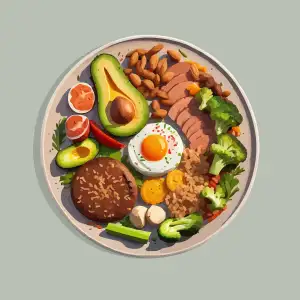Crunchy Delights: Master the Art of Frying Chicken with Our Step-by-Step Recipe Guide

- Selecting the right chicken pieces
- Preparing the chicken for frying
- Creating a flavorful marinade or seasoning
- Coating the chicken with flour or breadcrumbs
- Preheating the oil for frying
- Frying the chicken to perfection
- Draining excess oil from the fried chicken
- Serving and enjoying the crispy fried chicken
- Tips for variations and serving suggestions
Frying chicken is a culinary technique that has been enjoyed for centuries, resulting in crispy and flavorful delights. Whether you're a novice or an experienced cook, mastering the art of frying chicken can elevate your culinary skills. The process involves coating pieces of chicken with a seasoned flour or breadcrumb mixture and then frying them in hot oil until they turn golden brown and crispy. This method creates a delectable contrast between the juicy meat and the crunchy exterior, making it a favorite comfort food for many. So, let's dive into the world of frying chicken and discover the secrets to achieving that perfect crunch!
Selecting the right chicken pieces
Selecting the right chicken pieces is crucial for achieving the perfect fried chicken. Opt for bone-in, skin-on pieces like drumsticks, thighs, or wings as they retain moisture and add flavor. These cuts have a higher fat content, which results in juicier and more succulent fried chicken. Ensure that the chicken pieces are fresh and free from any discoloration or unpleasant odor. Remember to remove excess fat or feathers before proceeding with the preparation process.
Preparing the chicken for frying
Preparing the chicken for frying is an essential step in achieving crispy and delicious results. Start by rinsing the chicken pieces under cold water to remove any excess blood or debris. Pat them dry with paper towels to ensure a crispy exterior. Next, season the chicken with salt and pepper to enhance its natural flavors. For added depth, you can also marinate the chicken in buttermilk or a mixture of your favorite herbs and spices for at least 30 minutes or overnight in the refrigerator. This will help tenderize the meat and infuse it with additional flavor. Remember to discard any leftover marinade to prevent cross-contamination. By properly preparing the chicken, you'll be on your way to creating a mouthwatering fried dish that will leave everyone craving for more.
Creating a flavorful marinade or seasoning
Creating a flavorful marinade or seasoning is key to achieving delicious fried chicken. Start by marinating the chicken pieces in a mixture of buttermilk, salt, and your choice of herbs and spices. This not only adds flavor but also helps tenderize the meat. For a classic Southern taste, consider using paprika, garlic powder, onion powder, and cayenne pepper. Alternatively, you can experiment with different marinades such as soy sauce and ginger for an Asian-inspired twist or lemon juice and thyme for a refreshing citrus flavor. Allow the chicken to marinate for at least 4 hours or overnight in the refrigerator to let the flavors penetrate the meat.
Coating the chicken with flour or breadcrumbs
Coating the chicken with flour or breadcrumbs is a crucial step in achieving that perfect crispy texture. The coating not only adds a delightful crunch but also helps to seal in the moisture, ensuring juicy and tender meat.
To begin, prepare a shallow dish filled with all-purpose flour or breadcrumbs. You can choose between regular breadcrumbs, panko (Japanese breadcrumbs), or even seasoned breadcrumbs for an extra burst of flavor.
Before coating the chicken, make sure to shake off any excess marinade or seasoning. This will prevent clumps from forming and ensure an even coating. Dip each piece of chicken into the flour or breadcrumb mixture, pressing gently to adhere the coating evenly.
For a thicker and more substantial crust, you can repeat this process by dipping the coated chicken back into the marinade or seasoning and then into the flour or breadcrumb mixture again. This double-coating technique will result in an extra crispy exterior.
Once all the pieces are coated, let them rest for a few minutes to allow the coating to set. This will help it adhere better during frying.
Remember to handle the coated chicken with care to avoid disturbing the coating. Place each piece on a wire rack or baking sheet while you prepare for frying.
Coating your chicken with flour or breadcrumbs is an essential step that contributes to the overall taste and texture of your fried chicken. It creates that irresistible golden crust that everyone loves. So take your time and coat each piece thoroughly for a truly satisfying crunch when you bite into your deliciously fried chicken.
Preheating the oil for frying
Preheating the oil is a crucial step in achieving perfectly crispy fried chicken. To start, choose a high smoke point oil such as vegetable or canola oil, which can withstand the heat without burning. Pour enough oil into a deep frying pan or Dutch oven to fully submerge the chicken pieces. Heat the oil over medium-high heat until it reaches a temperature of around 350°F (175°C). Use a candy thermometer to accurately gauge the temperature. Preheating the oil ensures that the chicken cooks evenly and forms a golden brown crust.
Frying the chicken to perfection
Frying the chicken to perfection is a crucial step in achieving that crispy and golden exterior while ensuring the meat remains juicy and tender. To start, carefully lower the chicken pieces into the preheated oil, making sure not to overcrowd the pan. This allows for even cooking and prevents the temperature from dropping too much. Maintain a steady heat between 325-350°F (163-177°C) throughout the frying process. Cook each side for about 10-12 minutes until they turn a beautiful golden brown color. Use tongs or a slotted spoon to gently flip the chicken pieces halfway through cooking. Once done, transfer them onto a wire rack or paper towel-lined plate to drain excess oil. Remember, it's important to let the fried chicken rest for a few minutes before serving to allow the flavors to settle and ensure maximum crispiness.
Draining excess oil from the fried chicken
Draining excess oil from the fried chicken is an essential step to ensure a crispy and delicious final result. After frying the chicken to golden perfection, it's important to remove any excess oil to prevent it from becoming greasy.
To drain the excess oil, carefully lift each piece of fried chicken from the hot oil using tongs or a slotted spoon. Allow the chicken to rest on a wire rack or a plate lined with paper towels. The wire rack allows air to circulate around the chicken, preventing it from becoming soggy.
Let the chicken rest for a few minutes to allow any remaining oil to drip off. This will help maintain its crispiness and prevent it from becoming overly greasy. Gently patting the chicken with additional paper towels can also help absorb any excess oil.
It's crucial not to skip this step as draining the excess oil will enhance both the texture and flavor of your fried chicken. It ensures that you are left with perfectly crispy and mouthwatering bites that are not weighed down by unnecessary grease.
By taking the time to drain off excess oil, you'll be rewarded with a lighter and more enjoyable eating experience. So don't rush this step - let gravity do its work and allow your fried chicken to shine in all its crunchy glory!
Serving and enjoying the crispy fried chicken
Serving and enjoying the crispy fried chicken is the final step in mastering the art of frying chicken. Once the chicken has been cooked to golden perfection, it's time to present it in a way that truly showcases its crunchy delights.
To serve the fried chicken, you can place it on a platter lined with paper towels. This will help absorb any excess oil and keep the chicken crispy. Garnish with fresh herbs like parsley or cilantro for an added touch of freshness and color.
Fried chicken pairs well with a variety of side dishes. Classic options include mashed potatoes, coleslaw, cornbread, or biscuits. For a healthier twist, consider serving it alongside a crisp salad or roasted vegetables.
To enhance the flavor experience, offer a selection of dipping sauces such as barbecue sauce, honey mustard, or hot sauce. These condiments add an extra layer of tanginess or spiciness to complement the crispy exterior of the chicken.
When enjoying your crispy fried chicken, take a moment to appreciate its texture and aroma. The outer coating should be perfectly crispy while the meat inside remains juicy and tender. Each bite should provide a satisfying crunch followed by succulent flavors.
Remember that fried chicken is best enjoyed immediately after cooking when it is still piping hot and at its crispiest. So gather your friends and family around the table, share this delightful dish together, and savor every bite of this mouthwatering treat.
Tips for variations and serving suggestions
1. Spicy Twist: Add a kick to your fried chicken by incorporating spices like cayenne pepper, paprika, or chili powder into your marinade or seasoning mix. This will give your chicken a fiery flavor that will tantalize your taste buds.
2. Buttermilk Brine: For tender and juicy fried chicken, marinate the chicken pieces in buttermilk before coating them with flour or breadcrumbs. The acidity in the buttermilk helps to break down the proteins in the meat, resulting in a more tender and flavorful end result.
3. Asian Fusion: Experiment with Asian-inspired flavors by adding soy sauce, ginger, garlic, or sesame oil to your marinade or seasoning mix. This will give your fried chicken an exotic twist that pairs well with steamed rice or stir-fried vegetables.
4. Southern Comfort: For a classic Southern-style fried chicken experience, soak the chicken pieces in a mixture of saltwater and pickle juice overnight before frying. This technique adds moisture and imparts a tangy flavor reminiscent of traditional Southern cooking.
5. Dipping Sauces: Elevate your fried chicken experience by serving it with an array of delicious dipping sauces. Consider options like honey mustard, barbecue sauce, ranch dressing, or spicy mayo to complement the crispy exterior and add extra layers of flavor.
6. Creative Coatings: Step outside the box and experiment with different coatings for your fried chicken. Try crushed cornflakes, crushed potato chips, or even crushed pretzels for added texture and unique flavors.
7. Serving Suggestions: Serve your crispy fried chicken as a main course alongside mashed potatoes and gravy for a comforting meal. Alternatively, slice it up and serve it on top of fresh salad greens for a lighter option that still satisfies cravings.
These tips and suggestions will help you explore various flavors and presentations while mastering the art of frying chicken. Get creative in the kitchen and enjoy the crunchy delights of homemade fried chicken!
Frying chicken is an art that can be mastered with practice and attention to detail. By following our step-by-step recipe guide, you can create deliciously crispy fried chicken that will leave your taste buds craving for more.
Remember to select the right chicken pieces, whether it's bone-in or boneless, to ensure even cooking and maximum flavor. Preparing the chicken by cleaning and patting it dry is crucial for a crispy exterior. Creating a flavorful marinade or seasoning adds depth of flavor to the meat.
Coating the chicken with flour or breadcrumbs provides a crunchy texture that complements the juicy interior. Preheating the oil to the right temperature is essential for achieving golden-brown perfection.
When frying the chicken, maintain a consistent heat and avoid overcrowding the pan. This ensures even cooking and prevents the chicken from becoming greasy.
Once fried, draining excess oil on paper towels helps retain crispiness while reducing greasiness. Finally, serve and enjoy your crunchy delights with your favorite sides or dipping sauces.
For variations, try experimenting with different spices in your marinade or coating. You can also try using buttermilk instead of traditional marinades for a tangy twist.
In conclusion, mastering the art of frying chicken requires attention to detail but yields incredibly satisfying results. With our recipe guide as your companion, you'll be able to create mouthwatering fried chicken that will impress family and friends alike. So go ahead, savor the flavors and indulge in this timeless comfort food!
Published: 29. 02. 2024
Category: Recipes



